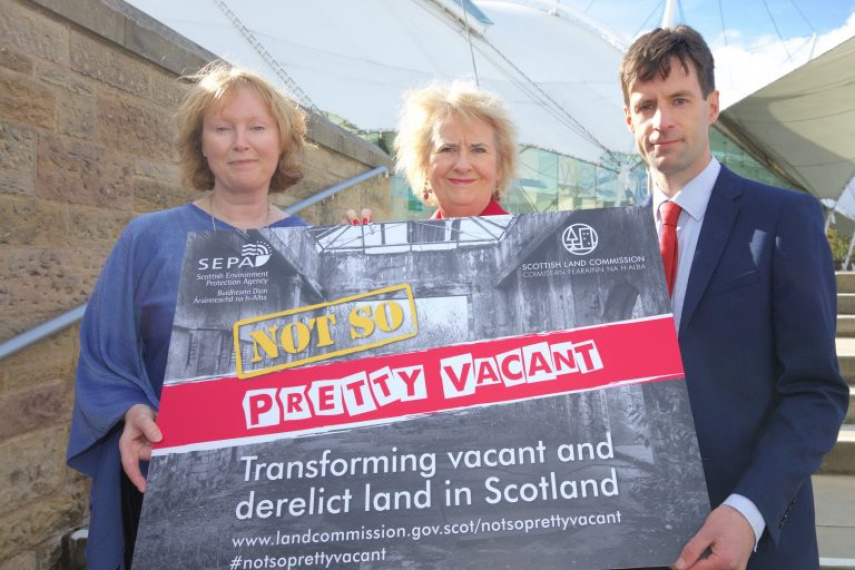Not so pretty vacant. Scottish Land Commission and SEPA target new uses for derelict and vacant land

Two of Scotland’s leading land and environment bodies have set their sights on finding ways to bring thousands of acres of derelict and vacant land back into productive use.
The Scottish Land Commission and SEPA have today launched their innovative partnership and taskforce to transform Scotland’s approach to vacant and derelict land. It will see the two organisations:
- Go beyond regulatory and planning compliance, to develop innovative approaches that will drive transformative – not piecemeal – change
- Challenge and change the way that Scotland deals with the issue of vacant and derelict land
- Work with local authorities, other public agencies and organisations in the private and social enterprise sectors to identify the causes and consequences of long-term land vacancy and dereliction
- Develop a 10 year strategy for eradicating the problem, setting ambitious targets supported at a local and national level.
The Scottish Vacant and Derelict Land Survey (SVDLS) was first set up 30 years ago, yet the amount of registered land has remained virtually static. There are currently around 11,600 hectares, two times the size of the City of Dundee, of derelict and urban vacant land in Scotland.
A new taskforce has been created, chaired by Steve Dunlop, Chief Executive Scottish Enterprise, to bring together leaders from the public, private and social enterprise sectors. The taskforce will challenge and reshape the approach to bringing sites back into use which will have both economic and social benefits for all of Scotland. Supported by the Land Commission and SEPA, the taskforce has the ambitious goal of halving the amount of Scotland’s derelict land by 2025. The partnership and taskforce was launched today at the at ‘Unlocking Inclusive Growth: The Social Value Gathering’ conference in Edinburgh.
Launching the partnership and taskforce, Land Reform Secretary, Roseanna Cunningham said:
“Scotland has far too much unused, unproductive land. As the Programme for Government makes clear, land can play a major role in creating high-quality places that support Scotland’s health, wellbeing and prosperity. The Scottish Government fully support the Scottish Land Commission and SEPA in investigating how this land could be better utilised by communities across the country, and I am keen to see an ambitious and innovative approach to this stubborn problem.
“The ‘unlocking’ of vacant and derelict land touches on a number of important strands of work, including planning and regeneration. It is also another key strand of our ambitious land reform agenda, which includes a recent commitment to continue our £10 million annual funding of the Scottish Land Fund, the creation of a register of controlling interests in land, and we’re exploring the expansion of existing Community Right to Buy mechanisms.”
Chair of the Taskforce Steve Dunlop said:
“In disadvantaged areas of Scotland it is estimated that three in every five people live within 500 metres of a vacant or derelict site. The taskforce will help drive practical action and look for innovative ways to make productive use of vacant and derelict land for housing, commercial and green space uses.
”Rejuvenating vacant and derelict land brings about long term regeneration and renewal – unlocking growth, reviving communities, increasing community empowerment, reducing inequalities and inspiring local pride and activities”
Chief Executive of the Scottish Land Commission, Hamish Trench, said:
“The partnership with SEPA and the creation of the Taskforce is a catalyst for change from across the sectors in our approach to vacant and derelict land. We want to identify what can be done with policy, legislation and action to release this land to benefit the communities living in and around it, making more of Scotland’s land do more for Scotland’s people.
“As part of that we, along with the taskforce, are looking at tools and mechanisms to address the problem of vacant and derelict land with scope for far more innovation in finding ways to bring the land back into productive use.
“There are already some inspiring – recent – examples of what can be achieved in our cities and we want to encourage more of these approaches.”
SEPA Chief Executive, Terry A’Hearn, said:
“Climate change, marine plastics and extreme weather events show that we are putting too much pressure on the environment. We are over-using the planet. But we are under-using some of our land.
“This Sustainable Growth Agreement with Scottish Land Commission is designed to fix this problem. This innovative partnership will transform Scotland’s approach to bringing vacant and derelict land back into productive use by turning once dormant liabilities into national assets.”
Recent examples of transforming vacant or derelict land for productive use include
- The Shettleston Growing Project in Glasgow which has created a thriving community garden on land previously used for storing building materials
- The recently completed Social Bite Village in Granton, Edinburgh to provide attractive accommodation for homeless people
- Scotland’s biggest and most ambitious regeneration programme Clyde Gateway has brought a number of large scale vacant derelict land sites back in to productive use, with the most recent being Magenta.
- Regeneration of a 28-acre site, formerly the home of Johnnie Walker, generating inward investment and stimulating jobs at HALO Kilmarnock